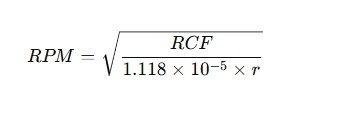Centrifugation is a fundamental process in laboratories across biology, clinical diagnostics, and chemistry. Yet, one common oversight among users is relying solely on RPM (revolutions per minute) without understanding RCF (relative centrifugal force), which is critical to experimental accuracy.
This article explains the difference between RPM and RCF, why RCF matters more, and how to set these parameters correctly for consistent, reproducible results.
RPM (Revolutions Per Minute): The speed at which the rotor spins.
RCF (Relative Centrifugal Force): The actual force exerted on the samples, expressed in ×g.
Relationship Formula
RCF = 1.118 × 10⁻⁵ × r × (RPM)²
(r = radius of rotation in cm)
|
Parameter |
Meaning |
Units |
|
RPM |
Rotor Speed |
rev/min |
|
RCF |
Centrifugal Force |
×g |
|
r |
Radius (from axis to sample) |
cm |
While RPM measures rotor speed, RCF reflects the actual gravitational force acting on your samples. Two different rotors spinning at the same RPM can generate vastly different RCFs due to varying radii.
Key reasons to prioritize RCF:
To ensure accurate and reliable results, follow these steps:
Goal: Achieve 15,000 ×g
Rotor Radius: 8 cm


|
Parameter |
Recommended Practice |
|
Time |
Match protocol duration; over/under spinning can harm results |
|
Temperature |
Use cooling (e.g., 4°C) for sensitive biological samples |
|
Acceleration |
Adjustable for fragile samples; use slower ramp up/down |
|
Brake |
Soft brake preferred to prevent pellet disturbance |
|
Short Spin |
Use for brief quick spins (optional setting) |
Modern centrifuges like Mether’s model offer real-time adjustment of RPM/RCF, temperature, and time during operation, allowing flexibility and control during runs.
Accurate centrifuge parameter settings are not optional—they are essential. Setting RCF correctly, along with other key variables like time and temperature, ensures that your experiments are reliable and reproducible.
Pro Tip: Consider investing in an advanced high-speed benchtop centrifuge like the Mether model, which offers RCF programming, automatic rotor recognition, and real-time adjustment for ultimate control.